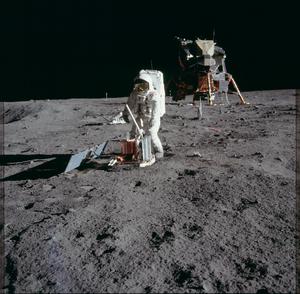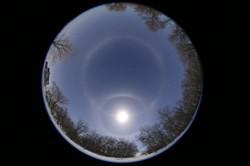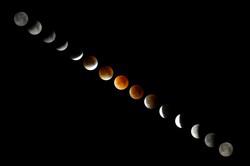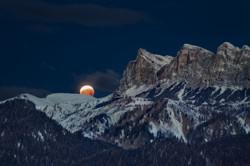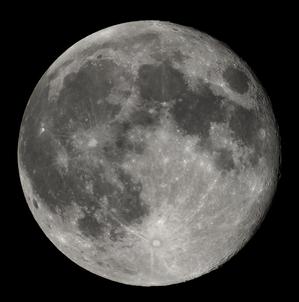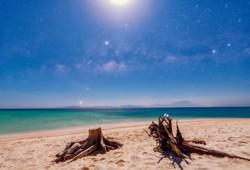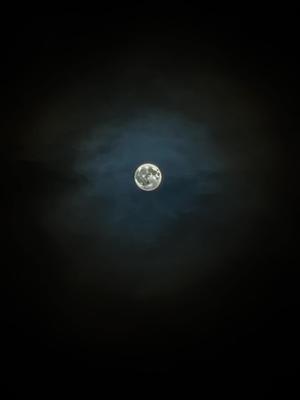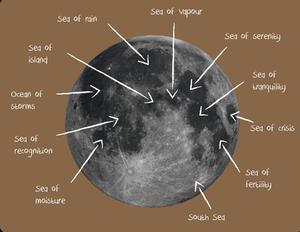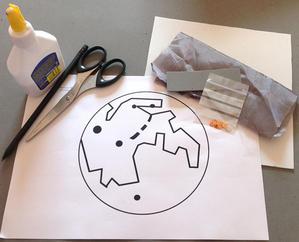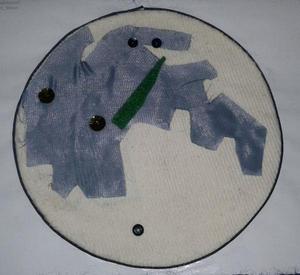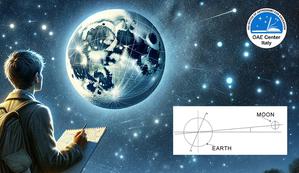Glossarbegriffe: Mond
Description: Der Mond ist ein Himmelskörper, der nicht von sich aus leuchtet, sondern der Sonnenlicht reflektiert. Je nachdem, wie die Sonne, der Mond und die Erde zueinander stehen, entstehen dadurch die charakteristischen Mondphasen. Der Mond ist der einzige große natürliche Satellit der Erde. Was Größe und Masse betrifft, steht der Mond an fünfter Stelle der natürlichen Satelliten im Sonnensystem. Da auch andere natürliche Satelliten als Monde bezeichnet werden, bezeichnen wir "unseren" Mond manchmal auch als Erdmond.
Im Vergleich zu anderen Monden des Sonnensystems ist der Mond im Verhältnis zur Größe des Planeten, den er umkreist, am größten. Der Mond umkreist die Erde auf einer elliptischen Bahn in einem durchschnittlichen Abstand von 384.000 km zur Erde. Er hat keine Atmosphäre und besteht aus ähnlichen Materialien wie die Erden selbst, mit einem eisenhaltigen Kern und gesteinshaltigen äußeren Schichten. Diese Ähnlichkeit ist kein Zufall: Soweit wir wissen, bildete sich der Mond aus den Trümmern einer Kollision zwischen der Erde und einem marsgroßen Protoplaneten vor etwa 4,5 Milliarden Jahren. Der größte Teil seines Materials stammt aus dem ursprünglichen Erdmantel.
Die Mondoberfläche hat dunkle Bereiche, die als Mare bekannt sind, sowie hellere Hochländer und ist übersät von Kratern. Die Oberfläche des Mondes ist 3,79 x 107 Quadratkilometer groß, sein Volumen beträgt 2,20 x 1010 Kubikmeter und seine Masse 7,35 x 1022 kg. Der genaue Wert der Umlaufzeit des Mondes um die Erde hängt vom Bezugsrahmen ab: Relativ zu den weit entfernten Fixsternen braucht 27,3 Tage für eine Umrundung ("siderische Periode"). Für einen Beobachter auf der Erde beträgt die Zeit zwischen zwei Neumonden 29,5 Tage ("synodische Periode").
Zugehörige Glossarbegriffe:
See this term in other languages
Term and definition status: The original definition of this term in English have been approved by a research astronomer and a teacher The translation of this term and its definition is still awaiting approval
The OAE Multilingual Glossary is a project of the IAU Office of Astronomy for Education (OAE) in collaboration with the IAU Office of Astronomy Outreach (OAO). The terms and definitions were chosen, written and reviewed by a collective effort from the OAE, the OAE Centers and Nodes, the OAE National Astronomy Education Coordinators (NAECs) and other volunteers. You can find a full list of credits here. All glossary terms and their definitions are released under a Creative Commons CC BY-4.0 license and should be credited to "IAU OAE".
Zugehörige Medien
Apollo 11 lunar activity
Bildnachweis: NASA/Project Apollo Archive credit link
License: PD Public Domain icons
Selene meets the Moon, by Sheila Wiwchar, Canada
Bildnachweis: Sheila Wiwchar/IAU OAE
License: CC-BY-4.0 Creative Commons Namensnennung 4.0 International (CC BY 4.0) icons
Red Moon, by Daniel Henrion, France
Bildnachweis: Daniel Henrion/IAU OAE
License: CC-BY-4.0 Creative Commons Namensnennung 4.0 International (CC BY 4.0) icons
The eclipsed Moon sets near the Rochetta di Prendera, Dolomiti Unesco, by Alessandra Masi, Italy
Bildnachweis: Alessandra Masi/IAU OAE
License: CC-BY-4.0 Creative Commons Namensnennung 4.0 International (CC BY 4.0) icons
Full moon
Bildnachweis: Luc Viatour credit link
License: CC-BY-SA-3.0 Creative Commons Namensnennung - Weitergabe unter gleichen Bedingungen 3.0 Unported icons
Mond-Merkur-Plejaden-Konjunktion
Bildnachweis: Giulio Colombo/ IAU OAE
License: CC-BY-4.0 Creative Commons Namensnennung 4.0 International (CC BY 4.0) icons
Die Sterne und das Meer gemeinsam bewachen
Bildnachweis: Likai Lin/IAU OAU
License: CC-BY-4.0 Creative Commons Namensnennung 4.0 International (CC BY 4.0) icons
Jupiter, Venus, Moon Conjunction
Bildnachweis: Joslynn Appel/IAU OAE (CC BY 4.0)
License: CC-BY-4.0 Creative Commons Namensnennung 4.0 International (CC BY 4.0) icons
Full Flower Moon 2023
Bildnachweis: Joslynn Appel/IAU OAE (CC BY 4.0)
License: CC-BY-4.0 Creative Commons Namensnennung 4.0 International (CC BY 4.0) icons
Lunar rainbow and lunar Brocken spectre, by Kouji Ohnishi, Japan
Bildnachweis: Kouji Ohnishi/IAU OAE
License: CC-BY-4.0 Creative Commons Namensnennung 4.0 International (CC BY 4.0) icons
Related Activities
Lunar Landscape
astroEDU educational activity (links to astroEDU website) Description: Create craters and explore the lunar landscape with this hands-on activity.License: CC-BY-4.0 Creative Commons Namensnennung 4.0 International (CC BY 4.0) icons
Tags: Hands-on , Model , Lunar landscape , Craters Age Ranges: 4-6 , 6-8 , 8-10 Education Level: Primary Areas of Learning: Modelling Costs: Medium Cost Group Size: Group Skills: Asking questions , Communicating information , Developing and using modelsMeet Our Neighbours: Moon
astroEDU educational activity (links to astroEDU website) Description: Explore the tactile version of our moon with household materials.License: CC-BY-4.0 Creative Commons Namensnennung 4.0 International (CC BY 4.0) icons
Tags: Hands-on , Model , Visually Impaired , Tactile Age Ranges: 6-8 , 8-10 , 10-12 Education Level: Middle School , Primary , Secondary Areas of Learning: Interactive Lecture , Modelling Costs: Low Cost Group Size: Group Skills: Analysing and interpreting data , Asking questions , Communicating information , Developing and using modelsLunar Day
astroEDU educational activity (links to astroEDU website) Description: Through a fun-learning activity, understand why moon always keeps the same face towards Earth.License: CC-BY-4.0 Creative Commons Namensnennung 4.0 International (CC BY 4.0) icons
Tags: Lunar day Age Ranges: 4-6 , 6-8 Education Level: Primary , Secondary Areas of Learning: Modelling , Structured-inquiry learning Costs: Free Duration: 30 mins Group Size: Group Skills: Analysing and interpreting data , Asking questions , Communicating information , Constructing explanations , Developing and using modelsSun, Earth and Moon Model
astroEDU educational activity (links to astroEDU website) Description: Build an Earth-Moon-Sun mobile to learn about how they orbit.License: CC-BY-4.0 Creative Commons Namensnennung 4.0 International (CC BY 4.0) icons
Tags: Hands-on , Model Age Ranges: 8-10 Education Level: Primary Areas of Learning: Game-mediated learning , Modelling , Social Research Costs: Medium Cost Duration: 1 hour 30 mins Group Size: Group Skills: Asking questions , Communicating information , Developing and using modelsChildren's Planetary Maps: The Moon
astroEDU educational activity (links to astroEDU website) Description: An up close look at our own satelliteLicense: CC-BY-4.0 Creative Commons Namensnennung 4.0 International (CC BY 4.0) icons
Tags: Maps , Planetary cartography , Spatial thinking Age Ranges: 6-8 , 8-10 , 10-12 , 12-14 Education Level: Middle School , Primary , Secondary Areas of Learning: Social Research Costs: Low Cost Duration: 2 hours Group Size: Group Skills: Analysing and interpreting data , Asking questions , Communicating information , Constructing explanations , Developing and using models , Engaging in argument from evidence , Planning and carrying out investigationsAge that crater!
astroEDU educational activity (links to astroEDU website) Description: Learn how to age craters with this Predict, Explain, Observe, Explain Activity!License: CC-BY-4.0 Creative Commons Namensnennung 4.0 International (CC BY 4.0) icons
Tags: Craters , Game , Maps , Geology Age Ranges: 4-6 , 6-8 , 8-10 Education Level: Middle School , Primary Areas of Learning: Observation based , Social Research Costs: Low Cost Duration: 1 hour Group Size: Group Skills: Asking questions , Communicating information , Constructing explanations , Developing and using models , Engaging in argument from evidenceChasing the Moon
astroEDU educational activity (links to astroEDU website) Description: Let's observe the Moon and learn how to measure its motion with simple observations and tools!License: CC-BY-4.0 Creative Commons Namensnennung 4.0 International (CC BY 4.0) icons
Age Ranges: 14-16 , 16-19 Education Level: Middle School , Secondary Areas of Learning: Guided-discovery learning , Observation based Duration: several days Skills: Analysing and interpreting data , Asking questions , Constructing explanations , Developing and using models